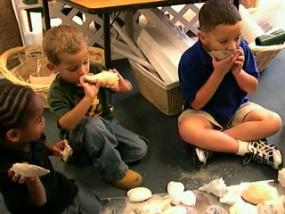From Exploring to Using Seashells

The children in this video clip are busy exploring seashells. We observe their actions so that we can provoke and support their in-depth investigations using this material. Providing time for children’s explorations of materials can also provide teachers, as astute observers, with relevant information. The information gleaned from teachers’ observations can be used to design rich problem-solving contexts, which have the potential to generate high level thinking about form and function. Below is a brief listing of some of the things the children in this video said and did. The capital letters are the children’s initials.
- Time Code 1
DB looks inside a bowl of shells.
G puts a small shell inside a larger shell. - Time Code 2
R also puts a small shell inside a larger shell.
DG pours sand from one shell to another.
DG: There’s a whale in here. He’s biting you already. - Time Code 3
RH pours sand into the shell held by P;
P stirs and pokes.
RH “sprays” P’s shell by making noise with his mouth. - Time Code 4 RH and P stir the contents together; the three shells are related.
- Time Code 6
DB “This one broke.
R “This one broke too.”
DB puts his mouth next to the shell bowl and says, “Hellooo.”
DB puts the shell to his ear (perhaps he saw DG do it). - Time Code 7
DG: This one looks like a phone (puts it up to his ear).
DB puts his shell to his ear, while looking at DG.
DG: Hello (puts the shell as phone to his ear, not to his mouth). - Time Code 8
DG: Nobody in here.
DG: Where are you… Dolphin? - Time Code 9
DG: There’s the ocean.
G puts his shell on the teacher’s left leg.
Teacher: You’re going to decorate my pants.
DB puts his shell on the teacher’s right leg. - Time Code 10
G moves DB’s shell to the teacher’s left leg.
We observe that the children in this video appear interested and prepared to engage in pretend play, using the seashells in many new ways. After sufficient exploration, the teachers could propose to the children that they are shipwrecked on a desert island. This pretense might encourage the children to consider the potential of the shells to function in a manner consistent with their form and substance. Desert island posters or slides projected on the wall could establish a context for the pretense. The teachers could further provoke the play by introducing a few ideas about possible shell functions that might be necessary for the island stranded people. For example, the shells might be used for cooking, fishing, music making, decorating, eating with, communicating at a distance, hunting with, and/or to help the stranded people sleep. Most likely the children would have many ideas themselves, once they caught onto the game. It would be best to work in small groups of three or four children. The teachers could set out pipe cleaners, string, glue, paper, and other materials that might encourage the children to think about the seashells as tools. The teachers should not be too concerned about making working models. It is the children’s thinking that will make this project a relevant learning experience.
Keywords: Fours, Children-Children, Exploration, Pretense, Communication, Function
Length of stand alone master video clip: 2 minutes 2 seconds
